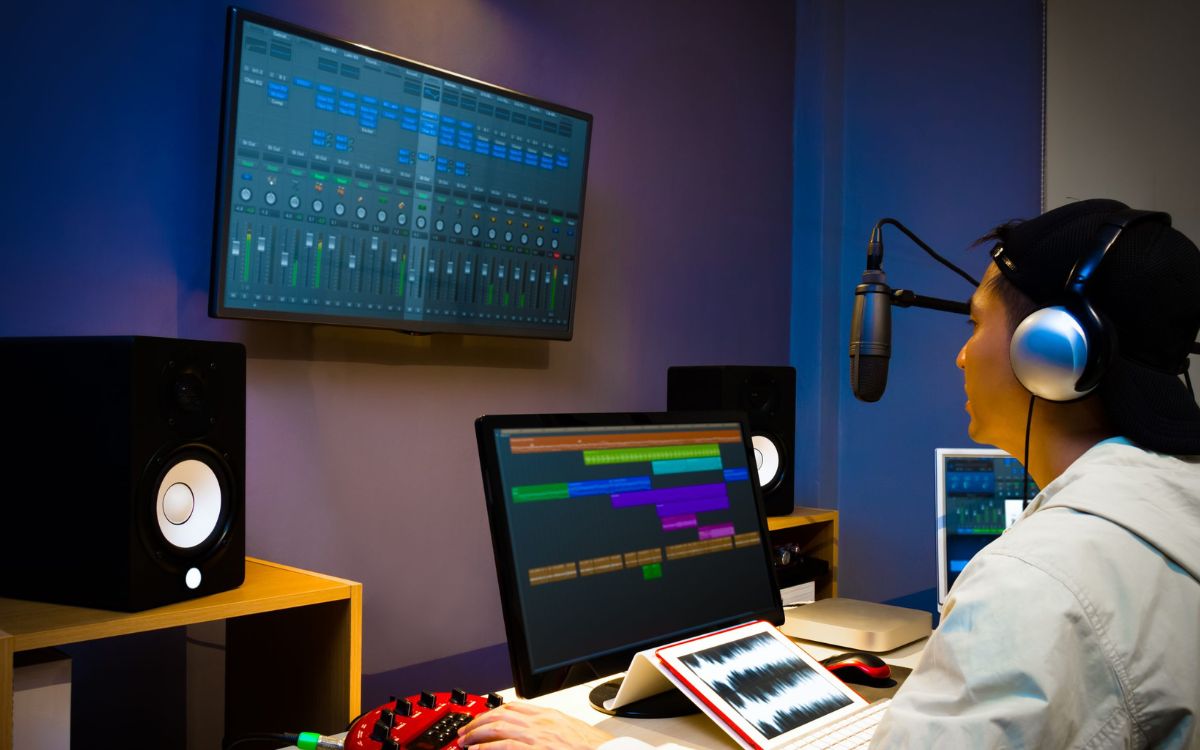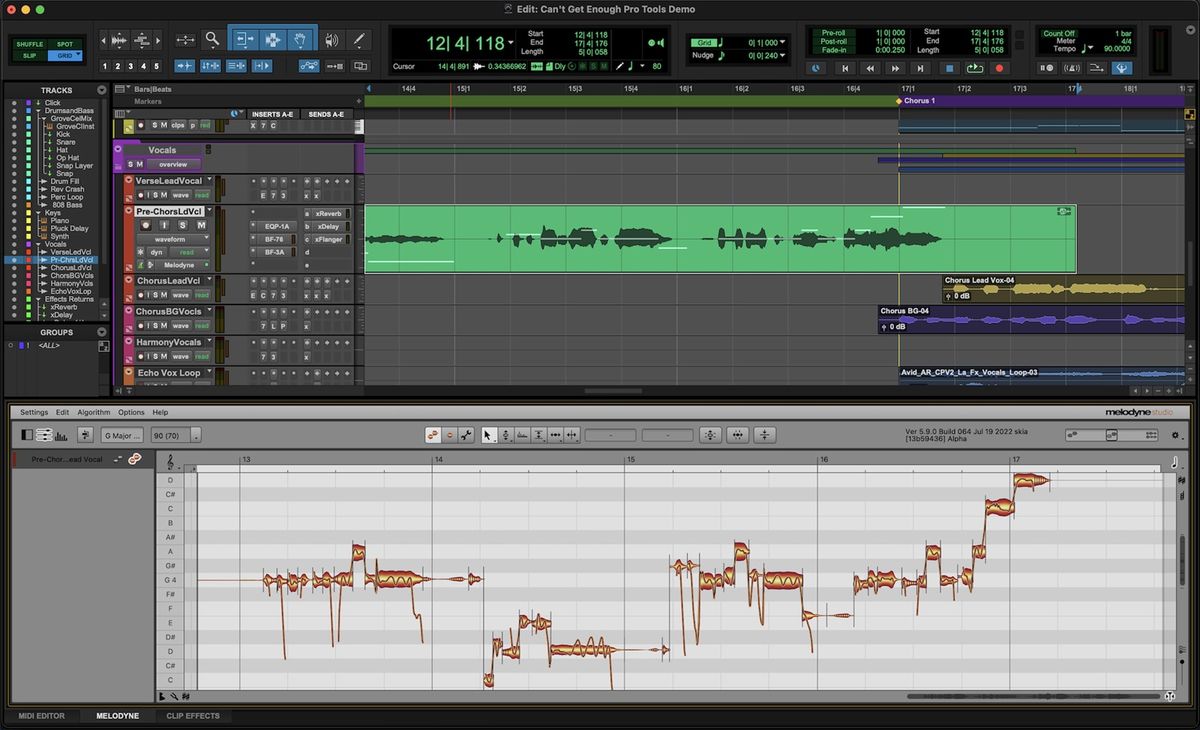Home>Events & Info>Podcast>What Software To Record Podcast


Podcast
What Software To Record Podcast
Modified: January 22, 2024
Discover the best software to record your podcast effortlessly. Enhance your podcasting experience with these top-rated tools.
(Many of the links in this article redirect to a specific reviewed product. Your purchase of these products through affiliate links helps to generate commission for AudioLover.com, at no extra cost. Learn more)
Table of Contents
Introduction
Welcome to the world of podcasts! Podcasting has quickly gained popularity as a powerful medium for sharing information, stories, and discussions. Whether you’re a solo host or part of a team, having the right software is crucial for recording and producing high-quality podcasts.
In this article, we will explore some of the top software options available for podcast recording. They offer a range of features and functionalities to suit different needs and preferences. From beginners to experienced podcasters, there’s something for everyone.
Choosing the right software is essential to ensure a smooth recording process and produce professional-sounding podcasts. Not only should the software be user-friendly, but it should also have advanced editing capabilities and provide options for customization.
No matter your level of expertise or budget, there are plenty of software options available to help you achieve your podcasting goals. Let’s dive into some of the top choices and find the perfect fit for your podcasting journey.
Choosing the Right Software
When it comes to choosing the right software for podcast recording, there are a few key factors to consider. These factors will help you determine which software aligns best with your needs, budget, and technical expertise. Here are some essential considerations:
- Ease of Use: If you’re new to podcasting or prefer a straightforward interface, look for software that offers a user-friendly experience. Some software options have intuitive controls and provide guided tutorials to help you get started quickly.
- Advanced Editing Features: Editing plays a crucial role in refining your podcast episodes. Look for software that offers advanced editing capabilities like cutting, trimming, EQ adjustments, noise removal, and volume normalization. This will allow you to enhance the overall quality of your recordings.
- Customization Options: Personalization is key in creating a unique podcast. Look for software that allows you to add intros, outros, music, and sound effects. This will help you establish a branded identity for your podcast and engage your audience.
- Compatibility: Ensure that the software you choose is compatible with your operating system (Windows, Mac, or Linux). You may also want to check if it supports the audio inputs and outputs you plan to use, such as USB microphones or audio interfaces.
- Remote Recording: If you have guests or co-hosts who are located in different places, consider software that offers remote recording capabilities. This will allow you to record interviews or discussions with ease, regardless of geographical constraints.
- Price: Podcasting software comes in a variety of price ranges. Consider your budget and evaluate different options, as some software may offer free versions or trial periods. Keep in mind that investing in advanced software can significantly enhance your podcasting experience.
Now that you have a better understanding of what to look for when choosing podcast recording software, let’s explore some of the top options available in the market.
Audacity
Audacity is a popular and free open-source software that has been a staple in the podcasting community for many years. It is available for Windows, Mac, and Linux, making it accessible to a wide range of users.
One of the greatest advantages of Audacity is its ease of use. The user-friendly interface allows beginners to start recording podcasts without a steep learning curve. It offers basic editing features such as cutting, copying, and pasting, as well as more advanced options like noise reduction and equalization.
With Audacity, you can also add effects to your recordings, such as reverb or compression, to enhance the overall sound quality. Additionally, it supports multi-track recording, allowing you to layer different audio files and create a more dynamic podcast episode.
While Audacity is a powerful and feature-rich software, it may not have all the advanced editing functionalities that some professional podcasters seek. However, for those with a limited budget or just starting out, Audacity provides a solid foundation for recording and editing podcasts.
Overall, Audacity is a reliable and versatile software option for podcasters of all skill levels. Its intuitive interface, editing capabilities, and compatibility across different operating systems make it a popular choice in the podcasting community.
GarageBand
If you’re an Apple user, GarageBand comes pre-installed on your Mac, making it a convenient and accessible choice for podcast recording. GarageBand offers a user-friendly interface and a wide range of features specifically tailored for podcasting and audio production.
GarageBand provides a variety of virtual instruments, loops, and sound effects that you can use to enhance your podcast episodes. It also supports multi-track recording, allowing you to create layered audio tracks and add depth to your recordings.
One of the standout features of GarageBand is its extensive library of royalty-free music and sound effects. This makes it easy to find and incorporate background music or soundscapes into your podcast, creating a more immersive listening experience for your audience.
In addition to its audio editing capabilities, GarageBand offers convenient post-production features. You can easily export your podcast episodes in multiple formats, including MP3, AAC, and WAV, and share them directly to podcast hosting platforms like Apple Podcasts or SoundCloud.
GarageBand is known for its seamless integration with other Apple products and services. If you have an iPhone or iPad, you can use the GarageBand iOS app to continue editing your podcast on the go. This level of compatibility and synchronization between devices is a significant advantage for Apple enthusiasts.
Overall, GarageBand is a powerful podcast recording software that offers a comprehensive set of tools and features. Its intuitive interface, extensive library of music and sound effects, and seamless integration with other Apple devices make it a top choice for podcasters within the Apple ecosystem.
Adobe Audition
If you’re looking for a professional-grade podcast recording software, Adobe Audition is a top contender. Adobe Audition offers a comprehensive suite of tools and features that cater to the needs of experienced podcasters and audio professionals.
With Adobe Audition, you have access to a wide array of advanced audio editing options. You can easily clean up and enhance your recordings using features like noise reduction, spectral frequency display, and advanced audio effects. This allows for precise control over the sound quality of your podcast episodes.
One of the standout features of Adobe Audition is its powerful multitrack editing capabilities. You can record multiple audio tracks simultaneously, making it ideal for podcasts with multiple hosts or guest interviews. The seamless integration of these tracks allows for easy editing, mixing, and mastering of your podcast episodes.
Adobe Audition also offers a range of automation features that can save you time and effort in the editing process. You can automate tasks like volume leveling, audio restoration, and speech alignment, streamlining your workflow and ensuring consistent audio quality throughout your episodes.
Furthermore, Adobe Audition supports importing and exporting projects in various file formats, including MP3, WAV, and AIFF. This gives you flexibility in sharing your podcast episodes across different platforms and ensures compatibility with popular podcast hosting services.
While Adobe Audition is a robust software option, it does come with a steeper learning curve compared to other tools. However, for podcasters seeking professional-grade audio editing capabilities and a range of sophisticated features, Adobe Audition is an excellent choice.
To access Adobe Audition, you can either subscribe to Adobe Creative Cloud, which includes additional Adobe software, or opt for a standalone Adobe Audition subscription. This may be a more significant investment compared to other software options, but it offers unparalleled flexibility and customization for your podcasting needs.
Hindenburg Journalist
Hindenburg Journalist is a podcast recording software specifically designed for journalists and storytellers. It offers a streamlined workflow and a range of features that make it an ideal choice for creating narrative-driven podcast episodes.
One of the key features of Hindenburg Journalist is its intuitive interface. The software is designed to prioritize simplicity and ease of use, allowing podcasters to focus on their storytelling rather than getting lost in technical complexities. The minimalist layout makes it easy to navigate, even for beginners.
Hindenburg Journalist includes advanced audio editing tools that help enhance the quality of your recordings. It provides features such as noise reduction, leveling, EQ adjustments, and voice profiling, ensuring that your podcast episodes sound professional and polished.
Another standout feature of Hindenburg Journalist is its Automatic Audio Cleanup tool. This feature analyzes your recordings and automatically applies noise reduction, compression, and EQ adjustments to optimize the sound quality. This saves you time in the editing process and ensures consistent audio quality.
The software also offers built-in collaboration tools, making it easy to work with co-hosts, editors, or remote guests. You can easily share files, track changes, and collaborate on the editing process, improving efficiency for podcasting teams.
Furthermore, Hindenburg Journalist includes advanced export options that allow you to export your podcast episodes in various file formats. This ensures compatibility with different podcast hosting platforms and gives you the flexibility to distribute your podcasts wherever you choose.
Although Hindenburg Journalist is focused on the needs of journalists and storytellers, it can be used by podcasters from various niches. Its user-friendly interface, advanced editing capabilities, and collaboration tools make it a valuable software for anyone looking to create engaging and professional podcasts.
Keep in mind that Hindenburg Journalist is a paid software, but it offers a free trial period for you to explore its features and determine if it aligns with your podcasting goals.
Zencastr
If you are looking for a reliable platform for remote podcast recordings, Zencastr is a popular choice. It is designed to simplify the process of recording high-quality podcasts with multiple participants, even when they are located in different locations.
One of the standout features of Zencastr is its seamless remote recording capabilities. It allows hosts and guests to join a virtual recording studio, offering separate audio tracks for each participant. This ensures crystal-clear audio quality and eliminates background noise or interruptions that can occur during online conference calls.
With Zencastr, you can record your podcast interviews in pristine quality that rivals in-person recordings. The isolated audio tracks can be individually edited, removing any echoes, background noise, or connection issues that may have occurred during the recording session.
Another key feature of Zencastr is automatic cloud-based backups. Your recordings are automatically saved to the cloud in real-time, providing an extra layer of security and preventing any data loss. This feature is especially beneficial in case of technical issues or internet connectivity problems during a recording session.
Additionally, Zencastr offers automatic post-production features like audio leveling and noise reduction. These features save you time in the editing process, allowing you to focus on the content of your podcast rather than spending hours on fine-tuning the audio.
Zencastr offers both free and paid plans, with the paid plans offering additional features like high-quality audio file downloads, enhanced processing, and advanced integrations with podcast hosting platforms. The free plan, however, may be sufficient for podcasters who are just starting out or have a small number of episodes.
If you frequently have remote guests or co-hosts on your podcast, Zencastr is a valuable tool that simplifies the recording process and ensures the highest audio quality for your episodes. Its intuitive interface, automatic backups, and post-production features make it a top choice for remote podcast recordings.
Anchor
Anchor is a user-friendly and free podcast recording software that caters to podcasters of all levels of experience. It offers a range of features that make it easy to create, edit, and distribute your podcast episodes with minimal effort.
One of the standout features of Anchor is its simplicity. The platform provides an intuitive interface that allows you to record and edit your podcast episodes directly from your computer or mobile device. The streamlined process makes it ideal for beginners or podcasters who prefer a hassle-free recording experience.
Anchor offers a variety of tools for editing and enhancing your podcast. You can trim and rearrange audio clips, add background music or sound effects, and even record voice messages from your listeners. The built-in editing features help you create professional-sounding podcasts without the need for external software.
Furthermore, Anchor provides seamless distribution options for your podcast episodes. With a single click, you can distribute your podcasts to popular podcasting platforms like Apple Podcasts, Spotify, Google Podcasts, and more. This ensures that your episodes reach a wider audience and saves you the hassle of manually submitting your feed to different platforms.
Anchor also offers monetization options for podcasters. You can easily monetize your podcast through sponsorships and integrate ads into your episodes. Anchor provides a simple and transparent monetization process, making it a convenient option for podcasters looking to monetize their content.
In addition to its user-friendly interface and distribution capabilities, Anchor also provides analytics to track your podcast’s performance. You can monitor your audience growth, episode downloads, and listener demographics, giving you valuable insights to tailor your content and engage with your audience more effectively.
Overall, Anchor is a versatile podcast recording software that offers a range of features for podcasters of all levels. Its simplicity, built-in editing tools, effortless distribution options, monetization opportunities, and analytics make it an attractive choice for podcasters looking for an all-in-one platform.
Whether you’re just starting out or looking to simplify your podcasting workflow, Anchor provides a user-friendly and accessible solution to help you create and share your podcast episodes with ease.
Conclusion
Choosing the right software for podcast recording is crucial for ensuring a smooth and professional podcasting experience. Each of the software options mentioned in this article offers unique features and functionalities to cater to different needs and preferences.
Audacity, with its simplicity and versatility, is an excellent choice for beginners or podcasters on a tight budget. It provides basic editing capabilities and compatibility across multiple operating systems.
GarageBand, a pre-installed software on Mac devices, offers a user-friendly interface and a range of advanced features like a vast library of music and sound effects, making it ideal for Apple users seeking convenience and creative options.
For those looking for professional-grade editing capabilities, Adobe Audition is a powerful option. It provides advanced tools for audio editing and post-production, making it the go-to software for experienced podcasters and audio professionals.
Hindenburg Journalist focuses on simplifying the podcasting process for journalists and storytellers. Its intuitive interface, powerful editing tools, and collaboration features make it an excellent choice for creating engaging narrative-driven podcast episodes.
If you frequently have remote guests or co-hosts, Zencastr offers seamless remote recording capabilities. Its isolated audio tracks and automatic cloud-based backups ensure high-quality recordings while eliminating technical issues.
Lastly, Anchor is a user-friendly and free platform that simplifies recording, editing, and distribution. Its straightforward interface, built-in editing features, and easy distribution to popular podcasting platforms make it a convenient choice for podcasters of all levels.
When selecting the software that best suits your needs, consider factors such as ease of use, editing capabilities, customization options, compatibility, and budget. Each software option reviewed here brings its own strengths to the table, so choose the one that aligns best with your podcasting goals and preferences.
Remember, the right software is just one piece of the puzzle. The content and quality of your podcast ultimately depend on your creativity, storytelling skills, and engagement with your audience. So, dive into the world of podcasting with the right software and let your voice be heard!











